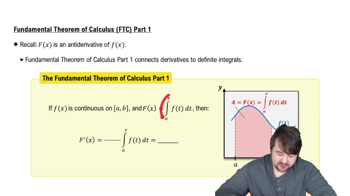a. Let f(x) be a function satisfying |f(x)| ≤ x² for −1 ≤ x ≤ 1. Show that f is differentiable at x = 0 and find f′(0).
Table of contents
- 0. Functions7h 54m
- Introduction to Functions16m
- Piecewise Functions10m
- Properties of Functions9m
- Common Functions1h 8m
- Transformations5m
- Combining Functions27m
- Exponent rules32m
- Exponential Functions28m
- Logarithmic Functions24m
- Properties of Logarithms36m
- Exponential & Logarithmic Equations35m
- Introduction to Trigonometric Functions38m
- Graphs of Trigonometric Functions44m
- Trigonometric Identities47m
- Inverse Trigonometric Functions48m
- 1. Limits and Continuity2h 2m
- 2. Intro to Derivatives1h 33m
- 3. Techniques of Differentiation3h 18m
- 4. Applications of Derivatives2h 38m
- 5. Graphical Applications of Derivatives6h 2m
- 6. Derivatives of Inverse, Exponential, & Logarithmic Functions2h 37m
- 7. Antiderivatives & Indefinite Integrals1h 26m
- 8. Definite Integrals4h 44m
- 9. Graphical Applications of Integrals2h 27m
- 10. Physics Applications of Integrals 3h 16m
- 11. Integrals of Inverse, Exponential, & Logarithmic Functions2h 31m
- 12. Techniques of Integration7h 41m
- 13. Intro to Differential Equations2h 55m
- 14. Sequences & Series5h 36m
- 15. Power Series2h 19m
- 16. Parametric Equations & Polar Coordinates7h 58m
2. Intro to Derivatives
Differentiability
Problem 3.2.60b
Textbook Question
b. Show that
f(x) = { x² sin(1/x), x ≠ 0
0, x = 0
is differentiable at x = 0 and find f′(0).
 Verified step by step guidance
Verified step by step guidance1
First, understand the definition of differentiability at a point. A function f(x) is differentiable at x = a if the limit of the difference quotient exists: lim(x -> a) [f(x) - f(a)] / (x - a).
For the given function f(x), we need to check differentiability at x = 0. The function is defined as f(x) = x² sin(1/x) for x ≠ 0 and f(x) = 0 for x = 0.
Calculate the difference quotient for f(x) at x = 0: [f(x) - f(0)] / (x - 0) = [x² sin(1/x) - 0] / x = x sin(1/x).
Evaluate the limit of x sin(1/x) as x approaches 0. Use the fact that |sin(1/x)| ≤ 1, so |x sin(1/x)| ≤ |x|. As x approaches 0, |x| approaches 0, thus the limit of x sin(1/x) is 0.
Since the limit exists and is equal to 0, f(x) is differentiable at x = 0. Therefore, f'(0) = 0.
 Verified video answer for a similar problem:
Verified video answer for a similar problem:This video solution was recommended by our tutors as helpful for the problem above
Video duration:
4mPlay a video:
Was this helpful?
Key Concepts
Here are the essential concepts you must grasp in order to answer the question correctly.
Differentiability
A function is differentiable at a point if it has a defined derivative at that point. This means the function must be continuous at the point, and the limit of the difference quotient must exist as the point is approached. For f(x) to be differentiable at x = 0, we need to check these conditions specifically at x = 0.
Recommended video:

Finding Differentials
Limit Definition of Derivative
The derivative of a function at a point is defined as the limit of the difference quotient as the interval approaches zero: f'(a) = lim (h -> 0) [(f(a+h) - f(a))/h]. For f(x) at x = 0, this involves evaluating the limit of [x² sin(1/x)]/x as x approaches 0, which simplifies to finding the behavior of x sin(1/x) as x approaches 0.
Recommended video:

Definition of the Definite Integral
Squeeze Theorem
The Squeeze Theorem is used to find the limit of a function trapped between two other functions that have the same limit at a point. If -1 ≤ sin(1/x) ≤ 1, then -x ≤ x sin(1/x) ≤ x. As x approaches 0, both -x and x approach 0, allowing us to conclude that x sin(1/x) also approaches 0, which is crucial for proving differentiability at x = 0.
Recommended video:

Fundamental Theorem of Calculus Part 1

 5:02m
5:02mWatch next
Master Determining Differentiability Graphically with a bite sized video explanation from Patrick
Start learningRelated Videos
Related Practice
Textbook Question
